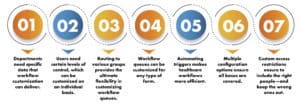As the regulatory environment grows and the complicated nature of medicine continues to require an “all hands on deck” approach, insurance Payers are searching for ways to get more done with less effort.
Payers have broad responsibilities from provider satisfaction, to communicating guidelines with healthcare administration teams. This role is critical in a properly functioning healthcare system and requires seemingly endless amounts of information coordination and paperwork.
For this reason, learning how to optimize workflows in healthcare has risen to be a top priority for many networks. These improvements come with an added benefit: transparency.
Customized workflow queues allow Payers to see user actions, monitor employee productivity, and provide spreadsheet reporting with customization specific to their needs.
Using machine learning and automation, Smart Data Solutions has been able to help companies leverage their existing resources to meet the demand of an ever-expanding industry and increase the experience for millions of patients across the nation.

Our 20+ years engrained in healthcare technology makes us the ideal partner for optimizing administrative workflows. Here are seven ways that insurance Payers leverage our technology through customized workflow queues.
- Departments need specific data that workflow customization can deliver.
Various departments require data delivered in different formats. Fortunately, we can organize information in limitless ways for any department. This means the people who need to see proper documentation get access to it in the time it’s needed. Information from outside organizations, such as clearinghouses or healthcare Networks, can be parsed and routed to their correct department without the need for human intervention.
- Users need certain levels of control, which can be customized on an individual basis.
Users can be added or removed to any workflow or have workflows set up under their credentials, enabling customized reporting specific to an individual or categorization by a user. This allows groups of users or specific employees who are handling particular information (i.e. specific claims) to have various data routed directly to them, creating comprehensive ownership of all relevant documentation.
- Routing to various groups provides the ultimate flexibility in customizing workflow queues.
Basic grouping gives more customization options beyond standard categorizations such as department or user. Information can be set to flow to both a department or individual as well as a custom-defined group allowing for greater access and flexibility when needed.
- Workflow queues can be customized for any type of form.
Proper forms and paperwork are an essential part of healthcare processing. Building workflows and parsing these documents allows for efficiency among staff and reduced error rates. All manner of forms can have custom workflows tailored to their unique properties and final destinations. These include appeals, grievances, eligibility, and more.
- Automating triggers makes healthcare workflows more efficient.
Countless amounts of paperwork are handled daily in both the healthcare and insurance industries. This paperwork generally requires a response form acknowledging that details are being processed or that, at minimum, the paperwork was received. SDS allows for triggers to be implemented that automatically push templated responses such as appeals, rejections, or acknowledgments when these documents are submitted.
- Multiple configuration options ensure all bases are covered.
Data and documentation often fall outside of what an institution considers “standard.” One-off or special information can require multiple configurations for sorting and delivery. Custom workflows can ensure that the right people or departments can be included alongside standard operating procedures.
- Custom access restrictions ensure to include the right people—and keep the wrong ones out.
Knowing that the right people or departments have access to the information they need is one thing, however, it’s peace of mind to know that the wrong parties can’t gain access. Restrictions can be implemented by users to ensure that access is defined appropriately. This isn’t only a security layer, but it also allows staff to forego redundant or superfluous workflows.
These customization features and more are available when you partner with SDS to optimize administrative workflows. Our QuickClaim portal lets you organize your workflow queues for your specific structure. Scanned images and documents can be moved from queue to queue or have their status changed.
All documents can be printed straight to your computer; they will be prepared by our system and a push notification will notify users when they are ready for download. Similarly, notation can be made on documents so that users down the line will have insight into unique circumstances or special instructions. Finally, users can see in real-time what is happening to any given document under their access.
Transparency is key in building infrastructure that benefits patients and practitioners alike. If you’re looking for a healthcare technology partner that enables maximum transparency and the ability to build efficient, effective workflows that help organizations thrive, contact SDS today. Our trained technologists work with you to define and implement custom queues specific to your needs.
To learn more, request a consultation and see how automation can assist your workflows.
